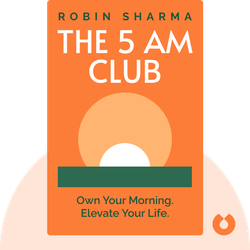Try Blinkist to get the key ideas from 7,000+ bestselling nonfiction titles and podcasts. Listen or read in just 15 minutes.
Start your free trial
Blink 3 of 8 - The 5 AM Club
by Robin Sharma

New Science, Ancient Wisdom, and Seven Practices of the Highest Happiness
Neurodharma by Rick Hanson is a guide to inner peace and happiness. It explores neuroscience and ancient wisdom to offer practical ways to find joy and purpose in life, and cultivate inner resilience.
If you’ve ever hiked up a mountain, you know how tough it can be. Not only is it physically exhausting, there are also obstacles and challenges along your way to the top.
Well, that’s what it’s like when achieving happiness, wisdom, and strength – qualities the author refers to as the “heights of human potential.”
We may all want to reach these heights – the metaphorical top of the mountain – but to get there, we have to tread a path of awakening first.
Here’s the key message: There are seven ways of being that form the basis of true awakening.
Many religious or spiritual traditions have their own versions of how to climb the mountain to happiness. But all of them seem to follow the same seven steps – steadiness, lovingness, fullness, wholeness, nowness, allness, and timelessness. Mastering these seven ways of being leads to enlightenment – otherwise known as full awakening.
Developing a greater sense of fullness, wholeness, or any other aspect of awakening involves three kinds of practice: Let be, let go and let in. Let’s take a look at these one by one.
First up, let be.
When you start on your path to enlightenment, you may notice a number of thoughts and emotions rising within you. Learning to let be means accepting these feelings as they come, and allowing yourself to feel them wholeheartedly.
Next up is let go, which means releasing what is painful or harmful. This can take the form of easing tension in your body, venting negative thoughts, or distancing yourself from desires that hurt you or others.
Last is let in. Once you’ve removed any negative thoughts or emotions, you can replace them with something positive. For instance, you could focus on developing new skills if you’ve not done well on a project, or on becoming more grateful and resilient after receiving negative feedback.
Think of it this way: If your mind is like a garden, you can pull out the weeds and plant flowers in their place.
So developing the seven ways of being requires that you experience feelings openly, accept them, and let them be. When you do this, you train yourself to be more mindful, loving, and content.
In the following blinks, we’ll take a look at how to practice these seven steps to enlightenment in our everyday lives. But first, let’s take a look at the neuroscience behind awakening, and how we can rewire our brains to improve our well-being.



Neurodharma (2020) offers a road map for achieving true happiness and fulfillment. Drawing on the ancient practices of Buddhism and modern neuroscience, author Rick Hanson outlines seven ways of being that can help you be more calm, compassionate, and present in the moment. He also gives practical tips and strategies for how to use meditation to improve overall well-being and effectiveness.
Neurodharma (2020) delves into the fascinating world of neuroscience and explores the connection between ancient wisdom and modern science. Here's why this book is worth your time:
Neurodharma is the truth of the mind grounded in the truth of the body.

It's highly addictive to get core insights on personally relevant topics without repetition or triviality. Added to that the apps ability to suggest kindred interests opens up a foundation of knowledge.
Great app. Good selection of book summaries you can read or listen to while commuting. Instead of scrolling through your social media news feed, this is a much better way to spend your spare time in my opinion.
Life changing. The concept of being able to grasp a book's main point in such a short time truly opens multiple opportunities to grow every area of your life at a faster rate.
Great app. Addicting. Perfect for wait times, morning coffee, evening before bed. Extremely well written, thorough, easy to use.
Try Blinkist to get the key ideas from 7,000+ bestselling nonfiction titles and podcasts. Listen or read in just 15 minutes.
Start your free trial
Blink 3 of 8 - The 5 AM Club
by Robin Sharma
What is the main message of Neurodharma?
The main message of Neurodharma is how to cultivate a deeper sense of well-being and fulfillment through neuroscience and mindfulness practices.
How long does it take to read Neurodharma?
The reading time for Neurodharma varies, but it typically takes several hours. However, you can read the Blinkist summary in just 15 minutes.
Is Neurodharma a good book? Is it worth reading?
Neurodharma is a valuable read. It provides insights into the intersection of neuroscience and mindfulness, offering practical ways to transform your life.
Who is the author of Neurodharma?
The author of Neurodharma is Rick Hanson.